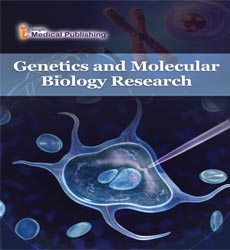The Molecular Studies of Bacteria and Visuses
Department of Molecular Biology, Calcutta University, India
- Corresponding Author:
- Soumodev Mal
Department of Molecular Biology
Calcutta University, India
E-mail: soumo123@gmail.com
Received Date: August 28, 2021; Accepted Date: September 13, 2021; Published Date: September 20, 2021
Citation: Mal S (2021) The Molecular Studies of Bacteria and Visuses. Genet Mol Biol Res Vol No: 5 Iss No:5:58
Copyright: © 2021 Mal S. This is an open-access article distributed under the terms of the Creative Commons Attribution License, which permits unrestricted use, distribution, and reproduction in any medium, provided the original author and source are credited.
Introduction
A model of the interactions between populations of temperate and virulent bacteriophage with sensitive, lysogenic, and resistant bacteria is presented. In the analysis of the properties of this model, particular consideration is given to the conditions under which temperate bacteriophage can become established and may be maintained in bacterial populations [1]. The effects of the presence of resistant bacteria and virulent phage on these “existence” conditions for temperate viruses are considered. It is demonstrated that under broad conditions temperate phage are going to be maintained in bacterial populations and can coexist with virulent phage. Extrapolating from this formal consideration of the population biology of temperate bacteriophage, variety of hypotheses for the conditions under which temperate, instead of virulent, modes of phage reproduction are to be anticipated and therefore the nature of the selective pressures resulting in the evolution and persistence of this “benign” sort of bacterial virus are reviewed and critically evaluated. Two hypotheses for the “advantages of temperance” are championed: (1) As a consequence of the allelopathic effects of diffusing phage, in physically structured habitats, lysogenic colonies are able to sequester resources and, therein way, have a plus when competing with sensitive nonlysogens. (2) Lysogeny is an adaptation for phage to require care of their populations in “hard times,” when the host bacterial density oscillates below that necessary for phage to be maintained by lytic infection alone. After a concise initial segment clarifying the fundamental standards of cytogenetics, the writer of this volume, which he styles a fairly progressed course reading, sets out quickly on the unique attributes of recombination measures in microorganisms, bacteriophages and parasites.
The incorporation of hereditary qualities and organic chemistry shapes the subject of the third part, which in the segment on freaks contains a record of some metabolic changes in man, Drosophila [2], Neurospora and different growths just as in microorganisms. To a limited extent 4, which concerns the hereditary fine construction of microorganisms, we read that in life forms going from Drosophila to bacteriophage the quantity of destinations per locus has been assessed at a huge number. Much proof is refered to show that in microorganisms, qualities controlling the particular strides in a biochemical grouping will in general be bunched together in a similar chromosomal area, regularly, however not perpetually, in the request for the response arrangement; cistron, muton and recon are clarified yet a clear inclination is communicated for the maintenance of the expression "quality" and the idea of "one quality one polypeptide chain". Partially 5, on transformations, the creator surveys the proof for change as the reason for variety in microbes and examines different strategies for assessing the change rate; prompted transformations of different kinds are likewise portrayed. Section 6, managing the physico-substance components of heredity, is given to a great extent to nucleic acids, their design and their connection to protein union, heredity, change and the hereditary code; regarding the instrument of recombination, we are informed that "the proof for broken matching and for chromosome breakage at the degree of DNA structure currently cause it to appear to be likely that these two variables are the essential determinants of recombinant arrangement". Section 7 carries us to the physiology and hereditary qualities of bacteriophages and incorporates conversations of the idea of the chromosomes of both phage and bacterium [3], and of the marvels of change, transduction and formation, and the activity of sex factors and episomes. The volume ends with the pregnant statement that "in microbes it is as of now beyond the realm of imagination to expect to define a firm boundary of division among chromosomal and cytoplasmic hereditary determinants, among viral and nonviral components, or even among viral and bacterial qualities [4]. All can converge into each other because of mutational and recombinational occasions". Large numbers of the terms utilized in hereditary qualities and cytology are disclosed by reference to their Greek roots, however for other people, like haploid, clone and karyogamy, no such clarifications are impending. The writer (or the editors) appears to have had some trouble with the orthography of words like presence and versatility.
References
- Callier V (2019) Core Concept: Gene transfers from bacteria and viruses may be shaping complex organisms. PNAS 116: 13714-13716.
- Sherry ST, Ward MH, Kholodov M, Baker J, Phan L, et al. (2001) dbSNP: the NCBI database of genetic variation. Nucleic Acids Research 29: 301-311.
- Kruglyak,L. (1999) Prospects for whole-genome linkage disequilibrium mapping of common disease genes. Nature Genet. 22: 139â??144.
- Collins,F.S. (1999) Shattuck lectureâ??medical and societal consequences of the Human Genome Project. N. Engl. J. Med. 341: 28â??37.
Open Access Journals
- Aquaculture & Veterinary Science
- Chemistry & Chemical Sciences
- Clinical Sciences
- Engineering
- General Science
- Genetics & Molecular Biology
- Health Care & Nursing
- Immunology & Microbiology
- Materials Science
- Mathematics & Physics
- Medical Sciences
- Neurology & Psychiatry
- Oncology & Cancer Science
- Pharmaceutical Sciences
